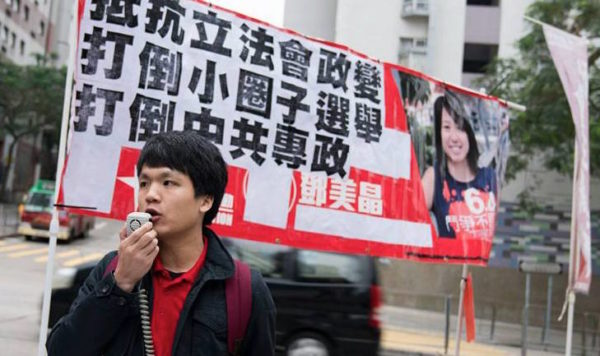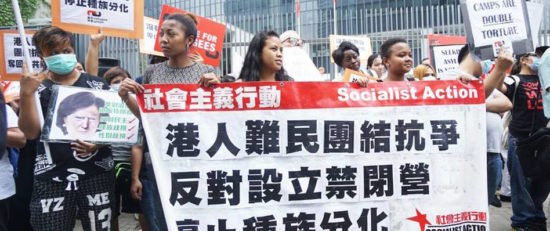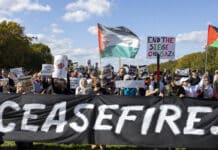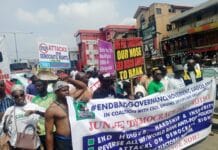The following statement was presented at a recent meeting of Socialist Action (CWI in Hong Kong) to discuss the important political shifts taking place at the start of 2017.
Hong Kong: “The eve of the storm”
1. The end of the CY Leung era finds Hong Kong in a state of unprecedented political turmoil, with massive rejection of establishment politics and a search for new alternatives. The political mood is complex, with explosive anger against the CCP dictatorship and its Hong Kong marionettes, checked by fear and anxiety, and a feeling of powerlessness to change the situation. The mood of anger is set to intensify, based on the crisis of capitalism and a parallel crisis of the dictatorial system. New political shocks and sudden explosions of struggle are rooted in the situation.
2. The lack of a working class, mass socialist alternative to offer a way forward, and the political spinelessness of the pan-democratic leaders, are the crucial factors explaining this contradictory mood. This is reflected in the fact that CY’s departure was not accompanied by a surge of self-confidence among the masses or a sense that the CCP-Hong Kong establishment has been forced to perform a tactical ‘retreat under fire’ – which is in fact the case.
3. Our organisation has been among the few voices to explain that the implosion of CY’s rule was in fact a delayed payment for the mass Umbrella Movement of 2014. That struggle displayed many positive features but was also hampered by fundamental political limitations: lack of a programme to combat the Chinese dictatorship and a one-dimensional Hong-Kong-only and occupy-only strategy.
4. Despite its failure because of these limitations to win concessions from the government, as we have explained in other material, the Umbrella Movement transformed Hong Kong’s political map from which there is no going back, even if political processes are confused and incomplete due to the absence of the ‘subjective factor’ of a resolute leadership for the anti-government struggle. It also enormously complicated Beijing’s problems in imposing “stability” in Hong Kong.
5. As we said at the time, CY emerged from this historic struggle as ‘damaged goods’ – a point now confirmed by Xi Jinping’s decision to abort his rule after one term, despite CY’s desperate last-minute attempts to save himself by creating a diversionary constitutional crisis (the Legco purge). The Chinese dictatorship aims to press ahead with hardline policies to extend its political and economic control over Hong Kong and exorcise the spectre of the democracy struggle. It remains committed to ‘CY Leungism’ but under a new face, and possibly some secondary policy adjustments. It hopes in this way to overcome the wall of mass resistance.
6. Our balance sheet of the 2014 events points out the following key points: The government ‘won’ by refusing to bend on its central stance against free/open elections in Hong Kong. But this came at the cost of destroying deeply held political illusions within society that have served the establishment as a powerful reserve in the past. The authority of the government and of state institutions (the police and courts), the magical power of the Basic Law, the mirage that “democracy is only a question of time”, and the authority of the government’s fellow illusion-peddlers, the pan-democratic leaders, all suffered irreversible damage in the Umbrella struggle and its aftermath.
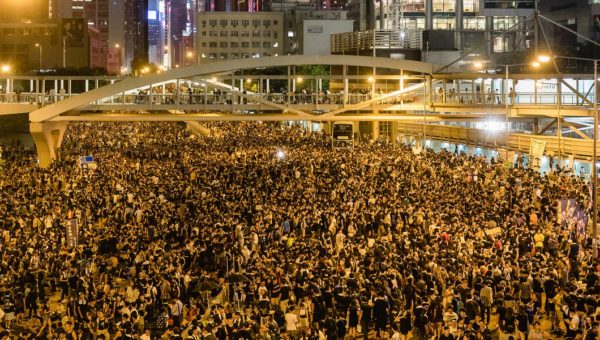
Economy: “a burning fuse for revolution”
7. Alongside sharp political polarisation and the historic crisis of governmental institutions, Hong Kong’s economy, based on an extreme form of monopoly capitalism and neo-liberal fundamentalism, has entered an era of unprecedented challenges and turmoil. The government warns of “mounting external uncertainties” in 2017 as it faces twin shocks from China’s debt-laden slowdown and ‘Trumponomics’ in the US, which by further sucking speculative capital into the US economy could push the dollar – to which Hong Kong’s economy is tied – even higher. This contains risks particularly for Hong Kong’s overinflated housing market if interest rates are dragged upwards.
8. This also threatens to further crimp Hong Kong’s retail and tourism sectors, which are heavily dependent on mainland Chinese spending, if the yuan’s ‘divorce’ from the US dollar accelerates (the yuan fell seven percent against the dollar in 2016). The retail, trade, hotel and restaurant sector is the biggest employer in Hong Kong, with almost 1.1 million workers. It is already a sector in trouble. Total retail spending fell 8 percent in 2016 and is set to fall 3 percent this year, according to the chairman of the Retail Management Association. Mainland and overseas visitors account for 30-40 percent of total retail spending and further falls in the value of the yuan are likely to increase the downward pressure in this sector.
9. Further slowdowns in economic growth can produce an explosive effect especially among the younger generation in such an unequal society. “Hong Kong’s appalling wealth gap is a burning fuse for revolution,” warned Yonden Lhatoo, a senior editor at the South China Morning Post (13 October 2016). He added “letting it [the wealth gap] continue unchecked will lead to social unrest on a historic scale”. The number of billionaires in Hong Kong quadrupled from 2003, the year of the half-a-million-strong ‘71’ protest against Article 23, to 2014, the year of the Umbrella Movement (increasing from 11 billionaires to 45).
10. At the same time there are now 300,000 children who don’t get three meals a day. Despite CY’s 2012 promises to “alleviate poverty”, this has worsened on his watch. The most recent government figures showed 20,000 more people were living below the official poverty line in 2015 from the year before – raising the total to 1.34 million, which is the highest number since 2009. And these are manipulated figures, with the government’s definition of poverty set at the absurdly low monthly level of HK$3,800 (US$490) per person. Within the overall picture the share of “working poor” is rising, exceeding 477,000 people in 2015. This includes 14,200 university graduates.
11. The growing alienation of the younger generation from the current capitalist order and against the Chinese dictatorship’s hardline enforcement of this order, is hardly surprising given the bleak economic future before working class youth and growing layers of middle class youth. Hong Kong’s child poverty rate in 2015 stood at 23.2 percent and there are more than 73,000 students on welfare assistance (CSSA). A much higher proportion of ethnic minority children live in families below the poverty line, at 33 per cent.
12. The deepening social crisis is compounded by the historical weakness of the labour movement and the fragmented nature of trade union organisations. There is an urgent need to mobilise older and younger workers in unionisation campaigns around issues like the minimum wage, such as we have seen in the United States with the strikes by fast food workers and the $15 Now movement, in which the supporters of the CWI have played an important role. Such campaigns can win broad support in society and spark the rebuilding of militant and truly democratic union organisations.
13. The current minimum wage of HK$32.50 is an insult to the workforce and represents an actual cut, in inflation-adjusted terms, of two dollars per hour compared to the already low starting point of the minimum wage set at HK$28 in 2011. “Washington, D.C., where the cost of living is similar to that of Hong Kong, has a minimum wage of US$10.50 (HK$81.60) – two and a half times higher,” explained Ming Chun Tang in the Hong Kong Free Press.
Explosive dialectic
14. Hong Kong politics are being driven by an explosive dialectic. Beijing’s undemocratic attacks stimulate resistance and an ever-greater democratic consciousness and sensitivity among the masses and especially the youth, which in turn increases the insecurity of a dictatorship which is living on borrowed time (and piles of debt). The dictatorship responds with even more hardline measures.
15. CCP propaganda is heavily laced with warnings against ‘colour’ (i.e. foreign-backed) revolution, but in reality the regime is haunted by fears of the genuine article – a grassroots working class rebellion – rather than ‘foreign pirate copies’. The sharpening contradiction between rulers and ruled is a formula for new explosions in China and Hong Kong and, at a certain stage, movements that could put the Hong Kong events of 2014 into the shade. Even a cop on the January 1 demonstration, commenting the smaller turnout, told one of our comrades, “We know this is just the eve of the storm”.
16. It is from this wellspring that localism rapidly emerged – a movement that due to its own severe political limitations is now in crisis. Armed with simplistic and demagogic slogans, a martyr complex, and rejection – in words – of the conciliatory role of the pan-democrats, they gained votes and support among youth especially, only to implode at the first real test (the Legco purge).
17. We oppose the racist ideology and right-wing economic programme upon which the majority of the localist forces stand. Their contradictory views on Hong Kong independence repeat the fundamental flaw of all reformist i.e. non-revolutionary approaches. They believe they have re-invented the wheel, but it is a pan-democratic wheel and it is square-shaped! This consists of avoiding at all costs the question of the need to overthrow the Chinese dictatorship. This can only be accomplished by a mass democratic movement led by an organised working class – in China, Hong Kong and the wider region.
18. The pan-democrats’ evade this problem by peddling the idea Hong Kong can get a separate democratic deal, through pragmatism, responsible opposition (kowtowing to the dictatorship), and not ‘going too far’. With this approach the pan-democrats have consistently acted to hold back and politically limit mass struggle.
19. The localists practice another variant of this deception. They peddle the more ludicrous illusion that the CCP dictatorship will reluctantly accept independence if enough people say they want it and engage in ‘resistance’ – rioting and racially-modified oaths being the only concrete examples. Sometimes Britain, Trump, the United Nations and other ‘democratic champions’ are curiously cited as allies in this struggle, by pan-democrats and localists alike. This shows almost childish naivety about capitalist politicians and institutions whose principles and actions are dictated by markets and dollars, not by ideals.
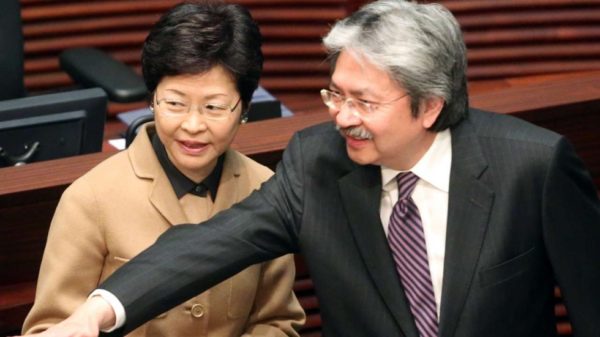
Crisis of the localists
20. The current crisis of localism, its paralysis and disintegration during the post-election political crisis, has given rise to a contradictory situation, which has partly cushioned the political impact of the governmental crisis and CY’s fall. While broadly welcomed, the hated leader’s demise has not noticeably raised the fighting morale in society. It is viewed by many as only a factional conflict at the top, rather than a result of mass pressure, and therefore beyond ordinary people’s control or influence.
21. This view is one-sided and therefore wrong: the intensification of the factional struggle within the capitalist and pro-CCP elite develops under the impact of mass pressure. This perception of being ‘bystanders’ unable to change political events is one of the consequences of the Umbrella outcome (“we gave it everything”) and is now reinforced by the collapse and demoralisation of localism, into which many hopes were transferred, especially among the most radical layers of youth as disillusionment with the pan-democrats hit new levels. This was shown by the meteoric rise of localist candidates to almost 240,000 votes (11.1 percent) in the first Legco elections since the Umbrella struggle. But subsequent events show the localists’ lack of roots – they rode on a favourable electoral wave, profiting from the lack of alternatives, but have been unable to defend these elected positions when attacked.
22. The stunning electoral gains – in the context of China and Hong Kong – of the localists made it absolutely inevitable the ruling class, and not only CY with his Machiavellian schemes, but all the CCP’s factions, would launch an assault to stamp out ‘separatism’. The capitalist media, the courts, police repression, etc, are being used to drive back and isolate the localists, who so far have produced no cohesive or organised reply. This illuminates all the political and organisational weaknesses of the localist groups: a confused and racially poisoned political outlook, a naive underestimation of what level and type of struggle is needed, and preference for anarchistic looseness and ‘spontaneity’ as against real organisation, a party.
23. In the short-term this contributes to what is a subdued mood at the outset of 2017, reflected in smaller marches and a complex, more pensive mood among the masses. Perhaps this mood is even stronger among the youth for the reasons explained above. However, this is only a temporary phase. Even the localists, currently in retreat, can pick up again or ‘reincarnate’ into new formations in the next period. Certainly, as we have explained, the mood for Hong Kong independence – CY’s gift to posterity – will not be stamped out by police methods and will boomerang on the ruling class in the future.
Prospects after CY
24. Despite the fall of CY and open warfare in the pro-Beijing camp, the pan-democratic leaders have once again done their utmost to snatch defeat from the jaws of potential victory. Their focus now is on electoral manoeuvres and possible deals with sections of the establishment – even within the stinking sewer of the Election Committee – while turning even further away from the road of mass struggle. Heavyweights within the pan-democratic leadership want to throw their support behind John Tsang Chun-wah to become the next Chief Executive as the “lesser evil” to Carrie Lam Cheng Yuet-ngor, who at this stage appears to be most favoured by Beijing.
25. The struggle to fill the Chief Executive’s post, which is really an exercise in damage control, presents Beijing with far bigger problems than ever before – worse even than the nightmare contest of 2012, when their two candidates engaged in ‘mutually assured destruction’. This fact belies the dictatorship’s image as an omnipotent force. The political crisis, which the regime’s struggle to recentralise power has created, has so undermined the institutions through which it exercises its rule in Hong Kong, that the “unthinkable” is no longer excluded: The CCP could lose control over a controlled election. According to an anonymous source close to the regime, quoted in the South China Morning Post, Beijing can now only fully rely on around 500 of the 1,194 votes in the Election Committee. The dictatorship now seems to be scrambling to avoid a contest that could see the narrowest of victories – more embarrassing even than CY’s 689 votes in 2012 – or even an invalid election which must be held again, thus putting the final nail in the coffin of its discredited ‘election’ system. For this reason, it cannot be excluded that Tsang will be ‘persuaded’ to pull out of the election.
26. The frictions within Hong Kong’s ruling elite, between the traditional tycoons who back Tsang, and the ‘red capitalists’ allied with CY, is a mirror of the fierce power struggle within the Chinese regime. Hong Kong and its media – tied to different elite interests – play an important role in China’s power struggle as a forum where the CCP factions can plant rumours and launch attacks on each other. This internecine struggle in the pro-Beijing camp has reached a level we have not seen before – of open warfare – as in the case of pro-Beijing newspaper Sing Pao’s attacks on CY, predicting his downfall as we did, and its allegations of a ‘Gang of Four’ centred on the Liaison Office. This could presage a major factional showdown within the CCP in the run up to the 19th Congress at the end of 2017, a development that would also have important ramifications for Hong Kong.
27. The idea floated by ‘Long Hair’ and the LSD to use the Chief Executive ‘election’ on 26 March to mobilise against all wings of the establishment should be supported. Such a challenge could potentially change the political situation with some parallels to the movement around Bernie Sanders and his ‘political revolution’ in the US. Socialists and consistent democrats oppose in general any participation in the regime’s small clique election process, but the proposal to nominate ‘Long Hair’, which would require 150 pan-democratic Election Committee votes of 325 possible, and then using this to turn to the masses for ‘public nominations’ as a means to mobilise mass opposition and attack the political programmes of all the establishment candidates could transform the current mood and offer a rallying point for creating a fighting mass movement against the dictatorship. This would also put the pan-democrats under pressure and expose the policy – which is absolutely criminal – of trying to cut a deal with the John Tsang wing of the establishment.
28. Our organisation and the entire democratic movement has been through a quite difficult and testing period since the Umbrella Movement, which led to a sharp downturn in struggle and confusion over how the movement could recover. There were features of reaction in the situation and indeed this is still the case, but this coexists with features of continuing radicalisation and the potential for sudden flare-ups of struggle. Events can develop rapidly in the next period and we must be prepared to orientate quickly to new turns in the situation. The coming period is likely to be a lot more favourable for socialism and the idea of a fighting working class alternative.
29. Above all there is the elephant in the room of developments in China, and the coming explosion of class struggle – an inevitability given the unbearable conditions of the working class and the poor. When the over 500-million-strong Chinese working class decisively enters onto the road of struggle against capitalism and the CCP regime, it will be the equivalent of a new superpower announcing its arrival on the scene. While all processes are subject to contradictions and complexities, mass working class struggle will act to cut across racism and ethnic divisions and create powerful impulses towards unity – on class rather than ‘national’ lines. The effect on Hong Kong will be irresistible, inspiring workers and other oppressed layers to organise and fight, and answering many of the doubts and questions in the minds of the Hong Kong masses about how the dictatorship can be confronted, and which methods are needed for victory. Like our opponents we must anticipate and prepare for the storm.
